Today is Bastille Day, the 223rd anniversary of the storming of the Bastille prison, much to the annoyance of the seven elderly prisoners being held there. To commemorate the day, I had two options. I could either build a barricade or do a blog post. Well, I'm slap out of cobblestones and extra furniture, so here's a blog entry tangentially related to the French Revolution. It's my undergraduate thesis. (With pictures!)
Liberte, Egalite, Fraternite,
Callie R.
Liberte, Egalite, Fraternite,
Callie R.
French society was in a state
of near-constant turmoil in the late eighteenth and nineteenth centuries. In a culture where women were inevitably
barred from the processes of political decision making, they instead made use
of popular political symbolism, charging even the seemingly innocuous realm of
high fashion with revolutionary sentiments.
The events surrounding the Paris Commune gave rise to several sudden and
striking shifts in the fashionable woman’s silhouette. The most startling
change in high fashion to trace its popularity to the Commune was the bustle
skirt. Beginning in the late 1860s,
previously circular hoops became more ovoid, and a slight padding was added at
the back of the dress. However, in 1870
and 1871, skirts deflated dramatically and became more cylindrical. The hoop skirt and previously ubiquitous
crinoline disappeared in a matter of months. The reasons for this rapid evolution of fashion were manifold: the circumstances of
the Franco-Prussian War and Paris Commune created a climate of intense
political upheaval; the Communards purposely embraced Jacobin symbols
associated with the Radical Revolution and the Terror; and the varying
depictions of women during the Commune forced the women of fashionable Paris to
adhere to often incompatible standards.
Prior to the outbreak of the
Franco-Prussian War, the upper echelons of French society relished the opulence
of the Second Empire. The reign of Napoleon
III was, for the wealthy, a time of economic prosperity and peace.[1] After sixty years of relatively austere
dress, bourgeoisie women again felt secure enough to dress themselves in
elaborate costumes, rivaling those of the ancien régime. Bright colors, often made by new,
artificial dyes, were generally the most popular: bright violet, pink, green,
glossy brown, and yellow.[2] In the earliest years of the Empire, from
approximately 1852 to 1856, shades of pink and blue were the most common, often
on gowns made of delicate moiré silk.[3] By the end of the decade, mauve and rose,
still rich, but more subdued, were the prominent colors, and fabrics were more
sumptuous.[4]
| Empress Eugenie and her Ladies |
The most recognizable feature of
Second Empire couture was, without a doubt, the crinoline. Skirts became fuller between 1852 and 1855,
and were trimmed delicately, with lace or velvet ribbon.[5] At this point, however, even the most
elaborate gown could be supported by a simple hoop skirt, a bell-shaped cage
typically made of whale bone, willow branches, or steel.[6] By the mid-1850s, the crinoline, a stiff,
layered underskirt made of horsehair, was added in order to support the
increasing diameter of the skirts.
Despite the crinoline’s ubiquitous presence in fashion plates, it was
not without controversy, due to its impracticability and its aesthetic value. Octave Uzanne, a nineteenth century fashion
writer, claimed it was a point of serious contention among ladies, and, despite
his tongue-in-cheek tone, he acknowledged the importance of fashion in France
and the passionate opinions of his fellow citizens and citizenesses. He stated, “No Frenchman was more
passionately absorbed in any political question than were his fellow
countrywomen in the discussion on the crinoline.[7]”
| 1853 |
| 1854 |
| 1857 |
| 1858 |
| 1860 |
| 1862 |
The full skirts popularized by
the Empress Eugénie, Napoleon III’s wife, and Princess Pauline von Metternich,
the wife of an important Austrian diplomat, sometimes measured as much as nine
feet in diameter and required up to 1100 yards of material.[8]
This elaborateness of dress was more
extreme than even the famous robes à la francaise, worn by Marie
Antoinette and ladies of the French Court.
In times of political unrest, both styles were viewed negatively, as
symbols of over-indulgence and excess, and were quickly abandoned as a matter
of political prudence.
By the late 1860s and the end
of the Empire, the French economy had begun to slow and Napoleon III’s
popularity was waning.[9] The bourgeois fixation on the ostentatious
was less pronounced, and the crinoline had begun to shrink. Gowns could typically again be supported by
starched petticoats or hoops. The gaiety of dress that had already begun to
fade by the late 1860s “fled in a trice, and [was] replaced by a sort of
concentrated seriousness bordering on remorse, and a simplicity of dress that
almost savored downright poverty.”[10] Even before the fall of the Empire, popular
opinion was beginning to turn against the excesses of the Court, and especially
the glamorous Empress Eugenie. Beginning
with the outbreak of the Franco-Prussian War, dress became more modest,
particularly around the neckline, and materials became less extravagant.[11] During the siege of Paris, citizens of all
classes were reduced to near starvation, creating a sense, if only for a brief
moment, of solidarity. In an etching
done in 1877 but based on sketches made in 1871, a bourgeois woman wearing a fichu
and robe à la polonaise collects money from men in working class
garb.[12]
| 1864 |
| 1867 |
| 1869 |
If the gowns of the Second
Empire were symbols of extravagance and wealth,
the fashions of the Paris Commune represented grief and unity. The color red was emblematic of the
Commune. Seen as the color of
revolution, the Commune’s flag was solid red, and its supporters wore red sashes
and scarves.[13] Marianne, the allegorical embodiment of
French republicanism, was most often depicted wearing red, or at least the infamous
bonnet rouge, the peaked Phrygian cap first worn by freed Roman slaves. Le Moniteur de la Mode advocated in
April 1871 wearing street clothes of black or another dark color. Anything bright would be in poor taste. Dark purple, grey, brown, black, and white
were, according to contemporary magazines, overwhelmingly the most popular
colors in spring of 1871.[14]
| 1871 |
Crêpe, a crinkled, gauzy fabric, which
was widely used in dresses of the era to symbolize mourning, soon took on a
patriotic meaning. The citizens of Paris
flew tricolor banners and drapes, often made out of the lightweight fabric.[15] After a time, the use of the material became
associated with flying the tricolor flag and a degree of patriotism. Domestic textiles became popular and, though
perhaps out of necessity, wearing “extremely fine French cashmere” and other
decidedly non-exotic materials, was considered patriotic and fashionable. This was a far cry from the days of the
Second Empire, when clothing made in and influenced by French colonies and
allies was desirable.[16]
| Dog and Cat Butcher |
The political turbulence and immense
hardships that began in 1870 were perhaps the most critical factor in the rapid
evolution of women’s fashion. On 15 July
1870, Emperor Napoleon III entered into a disastrous war with Prussia, over the
matter of succession to the Spanish throne. The Prussian chancellor, Otto von
Bismarck, had been attempting to draw France into war since 1868.[17]
Prussia was well-prepared for the
conflict: German Confederation troops numbered over 800,000. Comparatively, the French had only 360,000.[18] The fighting culminated in the Battle of
Sedan and the capture of Napoleon III and his armies, on 2 September 1870. On 4 September, crowds gathered peacefully at
the Place de la Concorde and the Hôtel de Ville organized and declared the Third
Republic, with General Louis Trochu as its interim president.[19]
Although the Second Empire collapsed
unexpectedly after Sedan, the provisional republican government took control
with relative ease. Prussian troops
arrived outside Paris in mid-September 1870, and laid siege to the city.[20] Parisians held out for five excruciating autumn
and winter months, as provincial armies tried and failed to drive away the
German Confederation’s forces. At the
beginning of the siege, Trochu estimated the city could sustain itself for
eighty days, and Parisians attempted to carry on as normally as possible. They communicated with the outside world via
pigeon and balloon, until prolonged rains, cold weather, and shorter days made
balloon flights impossible and pigeons unreliable.[21]
The atrocious conditions in
the besieged city of Paris led to a sense of socio-economic solidarity. While conservative French politician Adolphe
Thiers conducted inconclusive armistice negotiations with Bismarck, conditions
in the capital continued to deteriorate.
By December 1870, people of all classes had taken to eating horse, dog,
cat, and rat meat.[22] An engraving from early December depicts an
auction at the fish market. Men and
women are crowded together, bidding furiously for no more than a half-dozen
tiny fish. On the front row, amongst the
peasants and grisettes, an elegantly dressed young woman, with a lace
cap and ruffled robe à la polonaise stands calmly with an empty basket.[23] In a similar vein, newspaper etchings showed
the wealthy and commoners standing together in a butcher shop line. One 1871 illustration shows a “boucherie
canine et félin.” In the left
foreground, a woman in fur and a polonaise and a young man in a waistcoat and
top hat are sadly bringing their dogs to be slaughtered. On the right, two rough peasants look sadly
on their small puppy.[24] The exceptionally wealthy dined on
slaughtered zoo animals.[25]
Wine consumption tripled among
inhabitants, in an attempt to increase caloric intake, and dried albumin was
used as a substitute for eggs.[26] The winter was colder than average, seldom
reaching above freezing.[27] Flooding caused epidemics of typhoid, and
smallpox was rampant.[28] The death toll in October was ten times
higher than average. By January 1871, nearly 4500 Parisians were dying every
week, and infant mortality was close to ninety percent.[29]
| A fish auction, note the upper class woman |
| I'll let you run this through Google Translate by yourself. Go ahead. I'll wait. |
The Prussians began shelling
the capital in early January 1871, and talk of revolution in the crippled city
became more serious, as citizens grew angry over the government’s inability to
lift the siege.[30] On 28 January, Thiers capitulated to the
German armistice terms: Napoleon III’s disgraced army was to be exiled to
Switzerland until the peace treaty was signed and ratified. A 200 million franc indemnity had to be paid
by the city of Paris. The German
Confederation annexed the territories of
Alsace and most of Lorraine, with a combined population of 1.6 million, and
German soldiers paraded through the streets of the defeated city.[31] National elections for the new republic were
held only a fortnight after France’s surrender, primarily in an attempt to
stabilize and legitimize the young government.
However, circumstances were far from ideal, as nearly half a million
otherwise eligible citizens were disenfranchised by their status as prisoners
of war or refugees. Germans still
occupied many parts of France, and voting was hindered in those areas.[32] Voters in unoccupied territory were eager to
see the war end, and overwhelmingly supported Thiers. Additionally, monarchists won well over half
the seats in the National Assembly.
Thiers was elected president,
despite finishing twentieth out of forty-three candidates in Paris. The treaty was ratified overwhelmingly, and
six Parisian representatives resigned in disgust. This sense of outrage was shared by their
constituents, and by mid-February, the newly-formed Central Committee of Paris
was discussing autonomy. Seemingly in
anticipation of unrest, the Committee moved the 400 cannons, purchased to
defend the outskirts of the city during the siege, closer to the city center.[33]
Whether deliberate or not,
Thiers and the Assembly provoked the citizens of Paris with a series of harsh
policies. In early March 1871, he ended
the wartime moratoriums on rent and bills, despite the fact that the city was
nowhere near economic recovery. He chose
Versailles, rather than Paris, as the new government’s permanent home. Not only did Parisians feel slighted by the
move; the monarchist-led Assembly’s choice of the former royal palace as its
seat made many fear another attempt at a Bourbon restoration.[34] The new government cracked down on dissenters:
several popular left-wing newspapers were shut down, and some popular labor
leaders were tried and sentenced to death in absentia.[35]
The final blow came on 18 March
1871, when Thiers’s troops made an unsuccessful attempt to remove the cannon
from the Montmartre.[36] Though it was not declared officially until
28 March, the short-lived but bloody experiment known as the Paris Commune
began.[37]
| The French, doing what they do best. |
The Communards adopted the old
Republican calendar used during the First Republic, and a solid red flag. They implemented a policy separating church
and state, reinstated the wartime debt remissions Thiers had ended, abolished
night work in bakeries, established a pension fund for the unmarried lovers and
children of slain National Guardsmen, and established a policy of workers’
self-management.[38] Fighting between Republicans and Communards
began in earnest on 2 April 1871, although the Commune’s attempt to march on
Versailles the next day failed.[39] While neither side sought to escalate the
conflict, neither did either party express willingness to negotiate. Most famously, the Communards pulled down the
Vendôme Column, a monument to Napoleon Bonaparte, in the hopes that the action
would generate international support.
However, the national government successfully controlled the information
coming from the rebellious city, and the hoped-for support never came.[40]
| The infamous French Republican Calendar makes a return |
Throughout April and May, the
government forces grew in size, as returning French prisoners of war were
turned over to Thiers.[41] On 21 May 1871, a gate in the city’s western
wall was inadvertently left open and unmanned, allowing national troops to
reenter the city of Paris, where they were welcomed by the bourgeois residents
of affluent western neighborhoods.[42] The Communards were badly outnumbered and
lacked a centralized command or plan.
Each barricade was commanded by a local leader, with little
communication between them.
Additionally, the widening and repaving of Paris streets, undertaken by
Baron Haussmann in the previous decade, made building barricades in the streets
extremely difficult. As national troops
maneuvered to outflank Commune barricades, they slaughtered many
civilians. Though the Communards made
repeated attempts to arrange an exchange of hostages, Thiers refused, and both
sides executed many of their prisoners.[43]
By the last week of May,
nearly all of the barricades had fallen.
The few that remained were centered around the Parisian slums. Despite the efforts of rebel fighters, the
last barricade fell on the evening of 28 May.[44] The same night, national troops executed 147
Communards in Père Lachaise cemetery, thereby ending the semaine sanglante, or
Bloody Week.[45] Tens of thousands of Parisians were arrested
for their involvement with the Paris Commune.
Estimates for the number of Parisians killed during and immediately
after the Commune vary wildly. The
figure likely fell between 30,000 and 50,000: just as many, if not more, than
were killed during the Reign of Terror. Conversely,
the Versaillais troops suffered fewer than 1200 deaths and disappearances.[46]
| Dead Communards |
Precedents set by the French
Revolution established the symbolic power of high fashion, and the parallels
between Terror and Commune were not lost on the bourgeoisie. The robe à la francaise was synonymous
with the French Court at Versailles and the decadence of the French monarchy.[47] Made with yards of silk, the robe à la
francaise was an elaborate update of the robe volante, or sack
dress, popular in the mid-eighteenth century.[48] The bust was funnel-shaped, and the skirts
were wide and rectangular. The skirts
were opened in the front, in order to display an intricately decorated
underskirt. The complicated box pleats
down the back, the elaborate embroidery, and the robings, or skirt decorations,
ensured the robe à la francaise was worn only by the wealthiest ladies
of the Second Estate.[49]
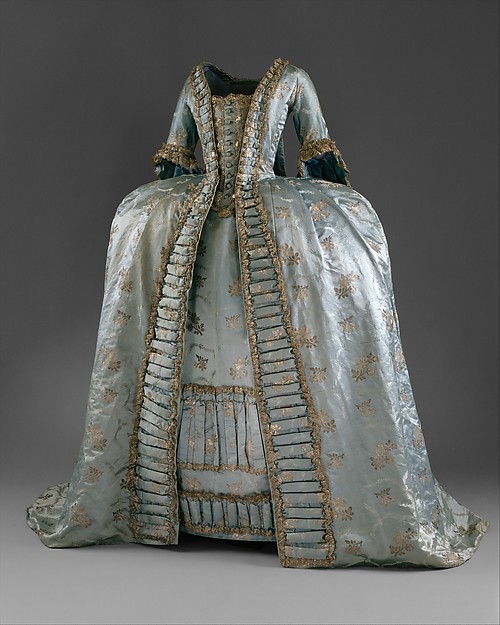
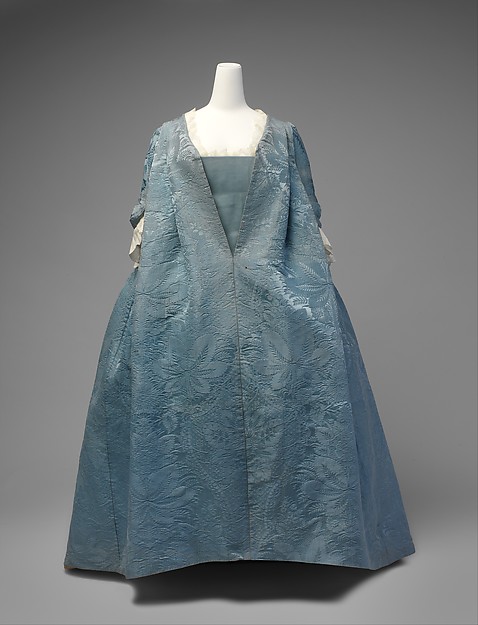
Robe a la francaise, 1765, Robe volante, 1730s
The robe à l’anglaise was
cut similarly, but with a fitted back instead of box pleats, and was often
nearly as ornate. It was, however,
extremely popular in the early stages of the Revolution, usually worn with a
thin triangular shawl, known as a fichu, imitating the pastoral costumes
of the paysannes, or French peasant women.[50] Following the arrest and execution of Louis
XVI and Marie Antoinette, the robes à la francaise and robes à
l’anglaise disappeared entirely. A
symbol of loyalty to the ancien régime and the monarchy, such opulence
was dangerous. Instead, women began to
wear the robe en gaulle, better known as the chemise dress.[51]
A fashion plate from Le
Moniteur de la Mode, dated April
1871 depicts a woman wearing two layered skirts. The first is of French
cashmere. The second is of English crepe, cut on the bias to resemble the skirt
of a peasant and worn long in the back, to allow ample material to drape.[52] This style of dress is known as a robe à
la polonaise. First popular among
French courtiers during the last quarter of the eighteenth century, it had a
distinctly pastoral look, and resembled dresses worn by paysannes.[53] The dress consisted of a very full skirt and
a fitted bodice. The skirt was rigged so
that it could be ruched or gathered in the back. Hooks and rings, cords and buttons, or simple
ribbon ties were used to adjust the skirt.[54] While it began as a novelty among ladies of
the French Court, during the Revolution it became a safety device. Adding cords or ribbons to tie up an overly
full skirt was a simple alteration, but meant the difference between the Second
and Third Estates. For similar reasons,
the robe à la polonaise became popular in 1871.[55] Though the bourgeoisie was not persecuted
specifically during the Commune, the violence of the era matched, if not
surpassed, the violence of the Terror.
There was an additional social pressure to adapt more austere styles,
and work alongside women of all classes and occupations was seen as a patriotic
duty.[56] Thus, the gown of the Second Empire could
easily become a robe à la paysanne.
Robe a la polonaise: 1871 and 1793
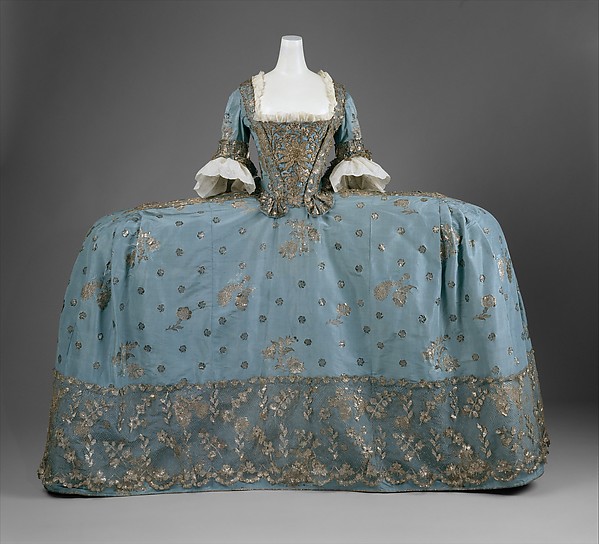
At their most opulent: 1750 and 1860
At their most austere: 1793 and 1872
In the late 1860s, Paul Klenck
produced a series of caricatures called The Imperial Menagerie, including
a scathing drawing of the Empress.
Entitled “La Montijo,” a reference to her Spanish surname, it depicts
Eugénie as a gypsy madwoman.[57] Her dress is opulent, though shown as a short
dancing costume. It also makes an oblique
reference to the excesses of the ancien régime: Eugenie’s dress is shown
as a robe à la francaise, with a pointed bodice and wide skirts. The London
Illustrated News published an engraving on 17 September 1870, depicting a
parade of French citizens celebrating the declaration of the Third
Republic. The parade is led by four
women, dressed in clothing typical of the Revolution. One woman wears a Pierrot bodice, one wears
an apron, one wears a robe en gaulle. They all wear tricolor cockades,
and their clothes are striped.[58] They resemble more closely the woman in the
1792 fashion plate entitled “French Women Who Have Become Free” than the
fashion plates of the Second Empire.[59]
 |
| Not the same etching cited above, but similar, from 1870 |
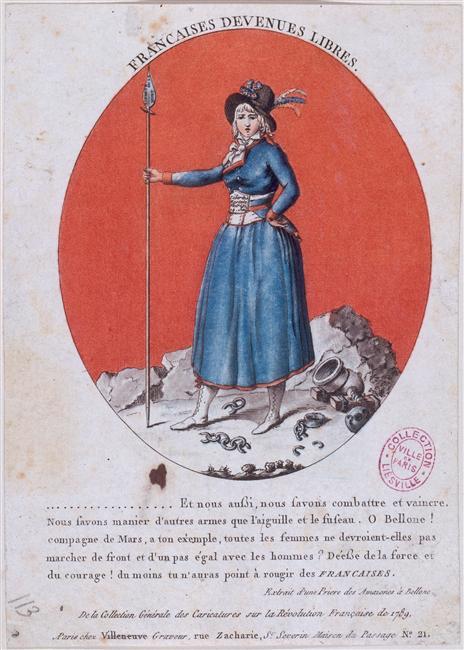 |
| French Women Have Become Free, 1792 fashion plate |
The leaders of the Paris Commune saw
their work as a second French Revolution.
They embraced the Jacobin influence with enthusiasm, despite its
association with the Reign of Terror. They
adopted the Republican calendar, first used from 1793 to 1805, and associated
with Robespierre’s attempts to secularize the calendar and redefine every
possible aspect of French life. A series
of caricatures by Paul Klenck, published during the Commune, depicts many of
its leaders in a Jacobin light. Paschal
Grossuet, a journalist and one of the leaders of the Commune, is shown holding
a red quill and ink pot. His body is
covered with a red-tinted copy of La Bouche du Fer, a popular left-wing
newspaper, published during the early days of the Radical Revolution.[60] Frederic Cournet, the leader of the National
Guard at Montmartre, is dressed in red, white, and blue, and wearing the
clothing of a sans-culottes, the radical working class men who formed the
original Paris Commune.[61] Felix Pyat, a Socialist leader, is also
dressed as a sans-culottes, and has the phrase ‘le vengeur’ inscribed on
his cap.[62] In a cartoon critical of Père Duchêne,
one of the two major pro-Commune newspapers, an issue of the paper is on a
table, and a bloody severed head rests on top of it, a quill tucked behind its
ear. The caption read “The True Père
Duchêne.” The cartoon implies that
the words of the Communards are written in blood, and not in ink, while calling
to mind images of the Terror and the guillotine.[63]
| The Guillotine Burns. Somehow, this did little to assure upper class Parisians. |
Although most prominent Communards
did not call for class warfare, some did, and their rhetoric was met with
enthusiasm.[64] Many Communards echoed the anticlerical
attitudes of their revolutionary predecessors, and false reports describing
massacres of priests, nuns, friars, and bishops were often picked up by
anti-Commune and sensational journals.[65] Perhaps most frightening to the upper class
Parisians, leading Communards formed an executive committee of five men, and
named it the Committee of Public Safety, after the Jacobin group formed by
Robespierre in 1793.[66]
Despite the Commune’s promise of
universal suffrage, women were excluded from official work. Instead, they formed vigilance committees,
gave public orations, pursued their own radical agendas, and fought on the
barricades during the Bloody Week.
Although they were forbidden to participate in any formal capacity, the
women of the Commune were by equal turns idealized and villainized, and female
images proved to be the most iconic of the Commune’s brief existence.
Marianne, the traditional
emblem of French republicanism, was depicted in many, often contradictory,
ways. She was by equal turns Amazon and
Vestal virgin, victim and aggressor, lover and warrior. She was at times seen as synonymous with all
of France, but often the two were separated.
Famed illustrator Gustave Doré depicted Marianne in 1870 as a republican
Joan of Arc figure.[67] She wears white robes, a white Phrygian cap,
carries a banner and sword, and leads a column of French troops. Klenck again depicted the stylishly dressed
Empress Eugénie, this time fleeing Paris after her husband’s defeat at
Sedan. She is chased by a furious
Marianne, wielding a broom, as opposed to her traditional flintlock or
tricolor.[68]

In the devastating aftermath of the
war, France was depicted almost exclusively as a victimized woman. In one 1871 lithograph, she lies in full
Classical regalia, on top of her shield, while Albion (dressed as Neptune, god
of the sea) looks on, sneering.[69] Daumier depicted her half nude in an
operating theatre, waiting to be butchered by the new National Assembly.[70]
In still another, she was depicted as a
Lucretia-figure, nude from the waist up, being butchered by Thiers.[71]
| Marianne as Victim |
However, this imagery evolved
immediately upon the founding of the Commune.
Daumier depicted Marianne with her traditional robes and Phrygian cap in
April 1871. In his illustration “The Chariot
of State,” she and Thiers were depicted driving the same cart, with horses
running in different directions, associating Marianne with Paris and the Commune,
not with France or the official Republican government.[72] This shift in symbolism was repeated
throughout the life of the Commune.
Another illustration depicted a relatively bourgeois Marianne in a solid
red bustled dress, bonnet rouge, and with breasts nearly exposed. She wears an anchor-shaped pendant around her
neck, likely an allusion to the broken chains found in more classical
representations. She watches warily as a
smirking Thiers, dressed as a cobbler, repairs a dainty red high-heeled boot. The
caption reads, “Ha! I will fix it so this one does not have the power to walk
anymore!”[73] Le Fils du Pere Duchêne, an ardently
pro-Commune satirical magazine depicted Marianne in wildly differing roles. The magazine printed ten issues, and Marianne
was on six of the covers: as a reluctant mother, an aggressor puppet, a
victimized puppet, a Classical bust, a bourgeois woman, and a courtesan leaving
her lover.[74] This illustrates not only the importance of
Marianne as a symbol of the Commune, but also her malleability.
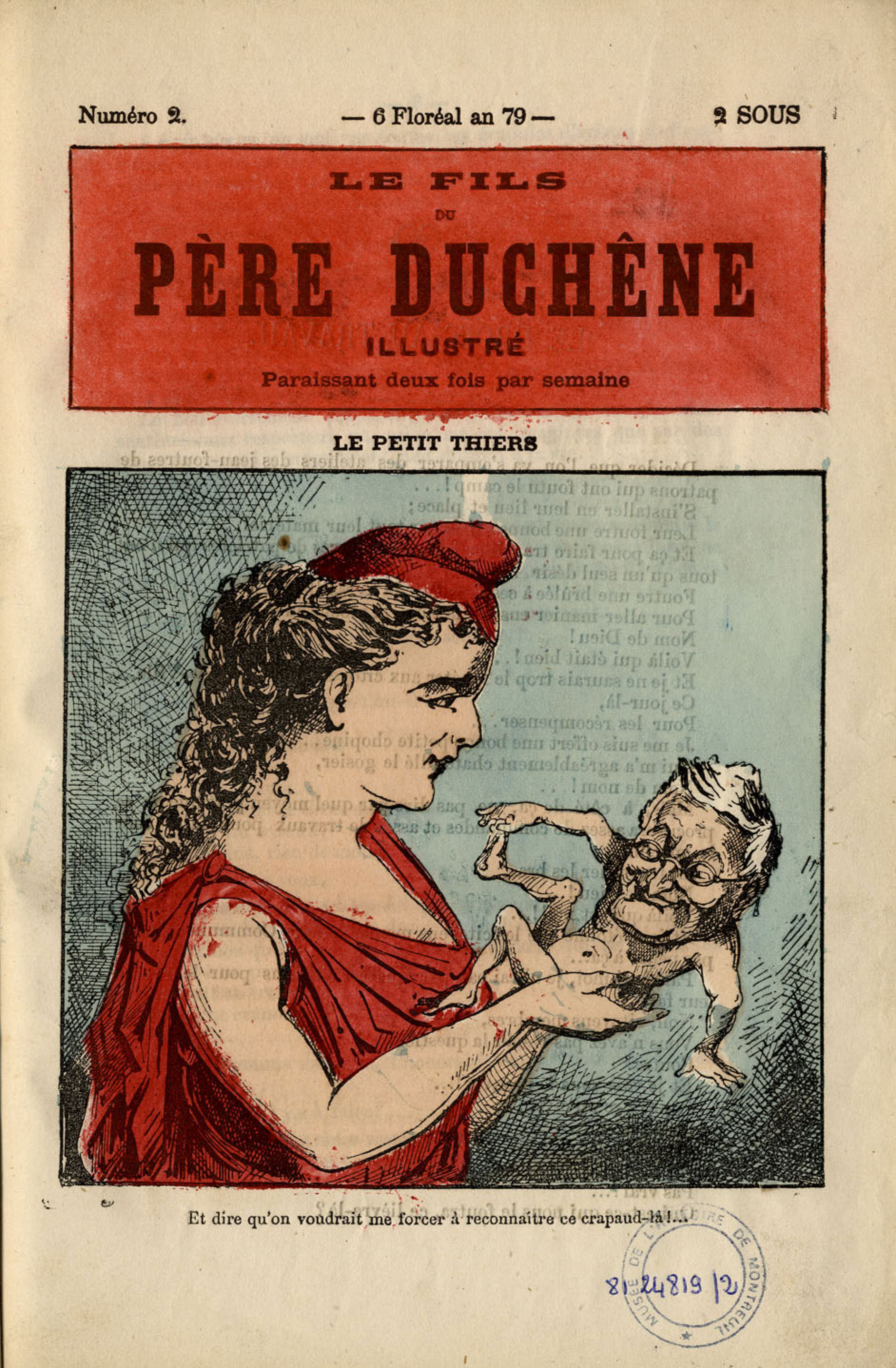
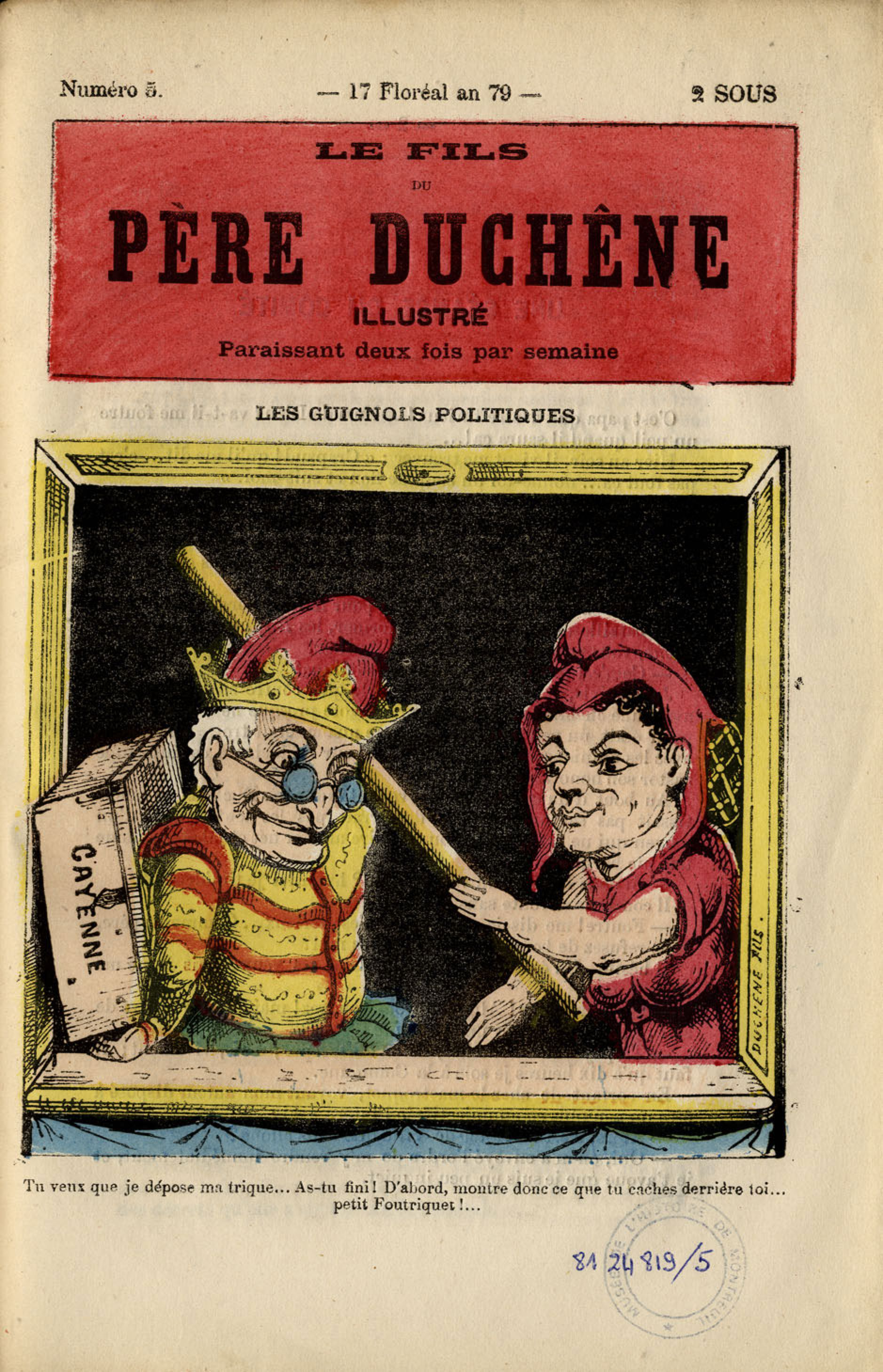


When the Commune fell, the
Third Republic reappropriated Marianne as a symbol. Doré satirized this by depicting Marianne as
a corpulent woman, barefoot, with a Phrygian cap, carrying her trademark
flintlock rifle in one hand and butcher knives in the other. Her breasts are covered, but bulging in her
too-tight robes, and her bonnet rouge is topped with a halo.[75] Daumier produced a series of grim takes on the
image of the French ideal. “The New Year” showed Marianne without her red cap,
wielding a broom, and sweeping up debris, including a bucket labeled “pétrole.” The illustration bore only the caption
‘1872.’ In another, he depicted her as a
skeleton, seated on the remains of a barricade, still draped in her robes, but
wearing a coquettish hat and playing the horn.
It was a satire of the hopeful and idealized depictions of Marianne that
began to appear in 1872. Finally, he
showed her as an emaciated corpse, in her robes and cap, lying in a
coffin. The caption read, “And all the
while, they insist she has never looked better.”
Female supporters of the Commune
were known as Communardes, and despite the lack of official female standing,
women played an integral role in the Commune.
From radical and highly visible activists like Louise Michel to
anonymous supporters, the Communardes provided a striking image in the public
imagination. They were depicted in
neutral or positive cartoons as being beautiful young women, wearing
militaristic boots, trousers, and bodices, with the simple skirts and aprons of
the working class.[76] Another etching published in London soon after
the fall of the Commune showed young women in upper class finery examining the
bodies of fallen street fighters. One
appears in full mourning, the others in demi-deuil, or
half-mourning. Two wear bustles and one
a polonaise, and their hats resemble Marianne’s Phrygian cap.[77] Similarly, an etching titled “The Triumph of
the Monarchy” depicted a skeletal and classically robed Death crowning Thiers
with a laurel wreath, atop a ruined barricade.
At their feet, lower and middle class women tend the wounded and mourn
the dead.[78]
Other accounts of the Communardes were
more scathing. Georges Clemenceau
described their “blood lust,” and likened them to “wild beasts.”[79] Many men proposed theories attempting to
explain the supposed behavior of the Communardes. Some suggested that they were, by nature,
more excitable and mentally weaker. Others
claimed they were evil and unnatural.
Alexandre Dumas, fils, referred to them as femelles, a
term used to describe female animals. He
claimed they resembled women only when they were dead.[80] Many assumed the Communardes were
prostitutes; others referred to the women in Classical terms, calling them
hecates, furies, harpies, and Amazons.[81] A lithograph called “The Defense of the
Commune” shows a woman in a Phrygian cap, wearing a short and tattered
tunic. Her right breast is bared, an
allusion to both the Virgin Mary and the Amazons. She stands on a barricade wielding a blade,
while other traditionally-dressed women kiss their lovers and tend to the wounded.[82] She is depicted much like an Amazonian
Marianne, however, and not as a loathsome pétroleuse.
Conversely, the popular image of the
pétroleuse was seized upon by the Versaillais for use in their
anti-Commune propaganda, and no image of the Commune captured the same place in
the public imagination. The pétroleuse,
a female arsonist, is almost certainly a creature of myth. Massive fires occurred in Paris, beginning in
earnest on 23 May 1871. The most
infamous casualty of the fires was the Palais des Tuileries, but entire suburbs
of Paris, financial buildings, the Hôtel de Ville, the Louvre, the Palais de
Justice, several theatres, and the docks at La Villette were burned, among many
other structures. The Versaillais likely
started the first fires on 22 May; the Communards were responsible for most of
the others, although supporters of the Commune also saved many structures,
including the National Archives and Notre Dame.[83] It is has thus far proven impossible to
determine the origins of the mythical pétroleuse.[84] Contemporary newspaper illustrations showed
the havoc wrought by the female arsonists, as well the execution of pétroleuses,
often dressed in flowing black, appropriating elements from the costumes of
both Marianne and Death.[85] Regardless of whether women were really
setting fires, and regardless of whether any pétroleuses were ever
actually executed, the press gave its readership the distinct impression that
it was happening with alarming frequency.
And though many drawings of the women depicted grotesque and androgynous
hags, several written accounts describing pétroleuses taken prisoner by
the Versaillais noted that there were women of all ages and social classes
among the accused.[86]
Although it first appeared in the
year prior to the Franco-Prussian War, the bustle skirt’s rapid ascent to the
realm of haute couture can be traced to the circumstances surrounding
the Paris Commune. The wartime emphasis
on austerity, the hardships of the Prussian siege, and a newfound sense of
solidarity between social classes, gave rise to a simpler and more practical
silhouette, as a matter of necessity and patriotism. Upon the declaration of the Third Republic,
the bustle’s cylindrical shape served as a pseudo-Classical symbol, and thus a
celebration of republicanism, and the ideals of liberté, égalité, and fraternité.
A climate of political fear arose at the formation of the Commune, and in
the chaos of the months that followed, women were bombarded with conflicting
images of the feminine ideal. As a
matter of political prudence, fashionable women were forced to drastically
alter their manner of dress in hopes of avoiding persecution. The Commune embraced the rhetoric and
symbolism of the Terror, and idealized the simply dressed Marianne. The Versaillais troops were also feared by
Parisians, as they moved through the city killing and arresting citizens at
random. The frequent and vivid, though
fictional, reports of les petroleuses captured the imagination of a
fearful city. The vitriolic accounts of
the Communardes, especially the focus on their unnatural and unwomanly
behavior, precluded the wearing of too-simple clothing, and made necessary the
accentuation of the female form. The
bustled skirt may be interpreted as the response of fashionable Parisian women
to the intense three-fold political
pressures of 1870 and 1871: the narrowed skirt as a wartime rejection of
opulence, the cylindrical shape as a celebration of republicanism, and the
padded bustle as an attempt to appease both the Communards calling for
revolution, and the Versaillais demanding traditional femininity.
Ancient Greece, 1800, and 1876
[1] David A.
Shafer, The Paris Commune (New York: Palgrave Macmillan, 2005), 8-9.
[2] Octave
Uzanne, Fashion in Paris: The Various Phases of Feminine Taste and
Aesthetics from the Revolution to the End of the XIXth Century (London:
William Heinemann, 1901), 128-130.
[3] Ibid.,
130.
[4] Ibid.,
133.
[5] Ibid.,
130.
[6] Ibid.,
130-131.
[7] Ibid.,
131.
[8] John
Milner, Art, War and Revolution in France 1870-1871: Myth, Reportage, and
Reality (New Haven: Yale University Press, 2000), 9-11.
[9] Shafer,
20-21.
[10] Uzanne,
147.
[11] Ibid.,
144.
[12] Milner,
103. Landing the Wounded at Pont d’Austerlitz, Paris, 1871. Wood
engraving, 31x46 cm. Illustrated London News, 21 January 1871.
[13] Gay L.
Gullickson, Unruly Women of Paris: Images of the Commune (Ithaca, NY:
Cornell University Press, 1996), 14-15.
[14] Le
Moniteur de la Mode, (Paris: Goubaud, 1 April 1871), 11-12.
[16] Le
Moniteur, 12.
[17] Shafer,
30.
[18] Ibid.,
34.
[19] Gay L.
Gullickson, Unruly Women of Paris: Images of the Commune (Ithaca:
Cornell University Press, 1996), 14-15.
[20] Shafer,
47.
[21] Ibid.,
48.
[22] Ibid.,
47.
[23] Milner,
94. “Inside Paris: A sale by Auction in the Fish Market (Sketch by Balloon
Post),” 1870. Wood engraving, 22.4x23.6 cm. Illustrated London News, 3
December 1870.
[24] Milner,
104. “The Market for Dogs’ and Cats’ Flesh, Paris,” 1871. Wood engraving, 22.4x24
cm. Illustrated London News, 28 January 1871.
[25] Shafer,
47-48.
[26] Ibid.,
49-50.
[27] Ibid.,
50.
[28] Ibid.,
51.
[29] Ibid.,
48-51.
[30] Milner,
110.
[31] Shafer,
54.
[32] Ibid.,
56.
[33] Ibid.,
54-57.
[34] Ibid.,
58-61.
[35] Ibid.,
59.
[36] Ibid.,
59.
[37] Ibid.,
62.
[38]
Gullickson, 19.
[39] Shafer,
75-77.
[40] Milner,
154-157.
[41] Shafer,
83.
[42] Milner,
161.
[43] Shafer,
91-92.
[44] Ibid.,
97.
[45] Milner,
180.
[46] Shafer,
97-98.
[47]
Metropolitan Museum of Art, Robe a la francaise, ca 1765.
2001.472a, b.
[48] Ibid., Robe
volante, ca 1730s. 2010.148.
[49] Ibid., Robe
a la francaise, ca 1785. C.I.65.13.2a-c.
[50] Ibid., Robe
a l’anglaise, ca 1787. C.I.66.39a, b.
[51]
Elizabeth Vigee-Lebrun. Comtesse de la Chatre (New York: Metropolitan
Museum of Art, 1789), 54.182.
[52] Le
Moniteur, 11.
[53]
Metropolitan Museum, Robe a la polonaise, ca 1793. 34.112a, b.
[54]
Metropolitan Museum of Art. 100 Dresses: The Costume Institute (New
York: Metropolitan Museum of Art, 2010), 18.
[55] Ibid.,
18-19.
[56] Uzanne,
148.
[57] Milner,
20. Paul Klenck, La Montijo. Musee d’art et d’histoire, Saint-Denis.
[58] Ibid.,
62. The Revolution in Paris: Celebrating the Proclamation of the Republic on
the Boulevard des Italiens, 1870. Illustrated London News, 17
September 1870.
[59]
Francois Bonneville. French Women Who Have Become Free. (Paris, 1792).
4232.2.42.73 <waddeson.org.uk>
[60] Paul
Klenck. La Commune: Paschal Grousset. (Paris: 1871), Victoria and Albert
Museum, E.2021-1962.
[61] Paul
Klenck. La Commune: Cournet. (Paris: 1871), Victoria and Albert Museum,
E.2022-1962.
[62] Paul
Klenck. La Commune: Felix Pyat. (Paris: 1871), Victoria and Albert
Museum, E.2013-1962.
[63] Georges
Pilotell. Le Vrai Pere Duchene. (Paris:1871), Northwestern University
Special Collections, 1-983.
[64]
Gullickson, 68.
[65]
Gullickson, 68.
[66] Ibid.,
69.
[67] Milner,
31. Gustave Dore. La Marseillaise, 1870. Musees d’art moderne et
contemporain de la Ville de Strasbourg.
[68] Milner,
61. Paul Klenck. The Departure of the Empress Eugenie (4 September 1870), 1870.
Musee d’art et d’histoire, Saint-Denis.
[69] Milner,
127. Cham. Oh no! Prussia has not yet completely killed her! It is still not
time to come to her aid, 1871. Musee du Louvre, Paris.
[70] Milner,
131. Honore Daumier. The Bordeaux Assembly- Who will take the knife?, 1871.
Le Charivari, 16 February 1871.
[71] Georges
Pilotell. L’executif, 1871. Victoria and Albert Museum, E.2214-1962.
[72] Milner,
150. Honore Daumier. The Chariot of State in 1871, 21 April 1871.
[73]
Faustin. Thiers et la Republique, 1871. Northwestern University Special
Collections, 1-1003.
[74]
Northwestern University Special Collections, 1-1015; Wikimedia Commons.
[75] Milner,
184. Gustave Dore. La Republique, 1871. Musees d’art Moderne et
Contemporain de la Ville de Strasbourg.
[76]
Gullickson, 3-4.
[77] Milner,
161. A Street Incident in Paris, 1871. Illustrated London News, 10
June 1871.
[78]
Gullickson, 84. The Triumph of the Monarchy, 1871. Bibliotheque
Nationale.
[79]
Gullickson, 52.
[80]
Gullickson, 4-5.
[81]
Gullickson, 4.
[82] Milner,
162. Dupendant. The Defence of the Commune, 1871. Musee d’art et
d’histoire, Saint-Denis.
[83] Shafer,
98-99.
[84] Shafer,
158-159.
[85]
Gullickson, 188. The End of the Commune: Execution of a Petroleuse, 10
June 1871. Bibliotheque Nationale.
[86]
Gullickson, 174.
No comments:
Post a Comment